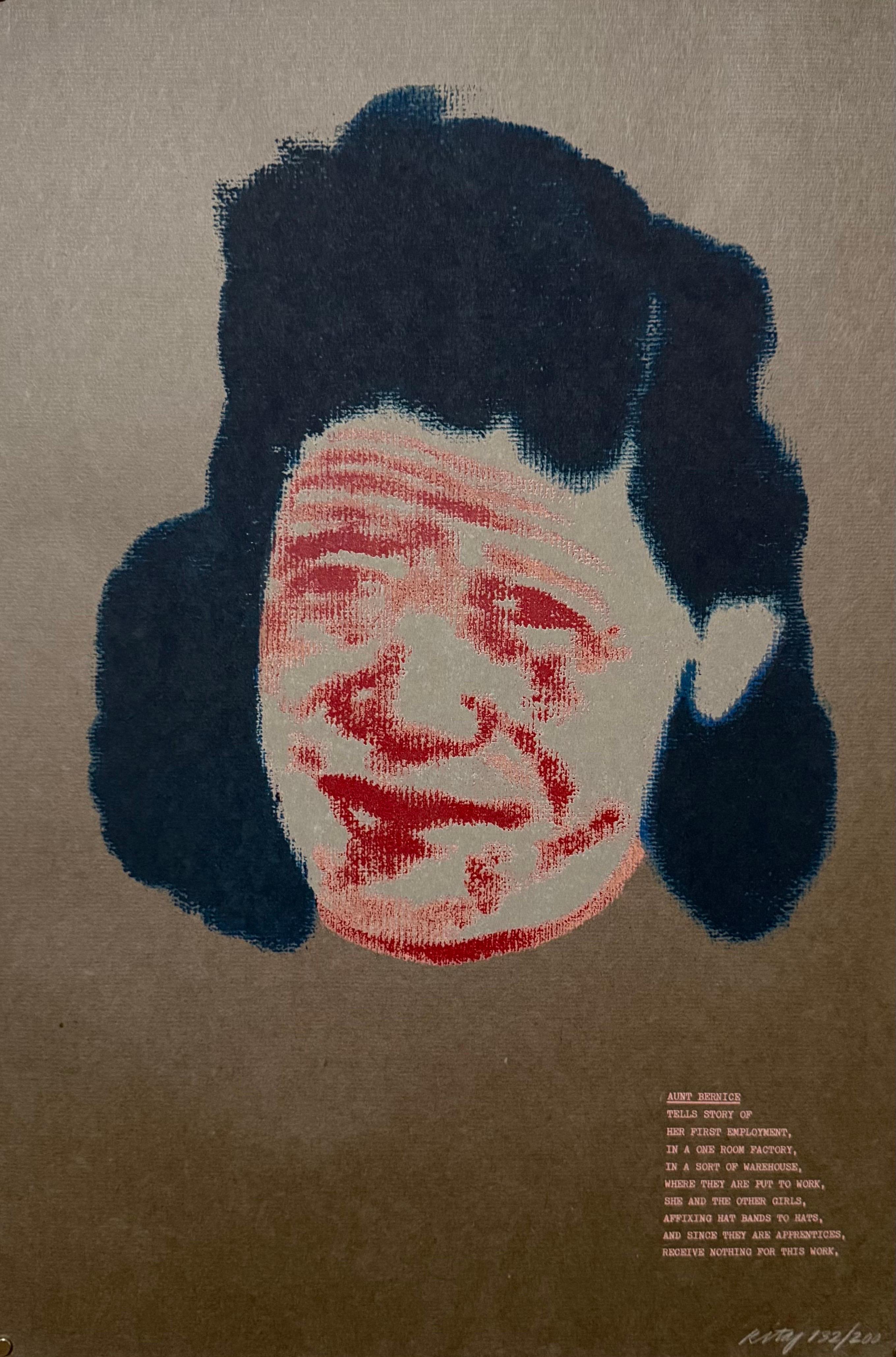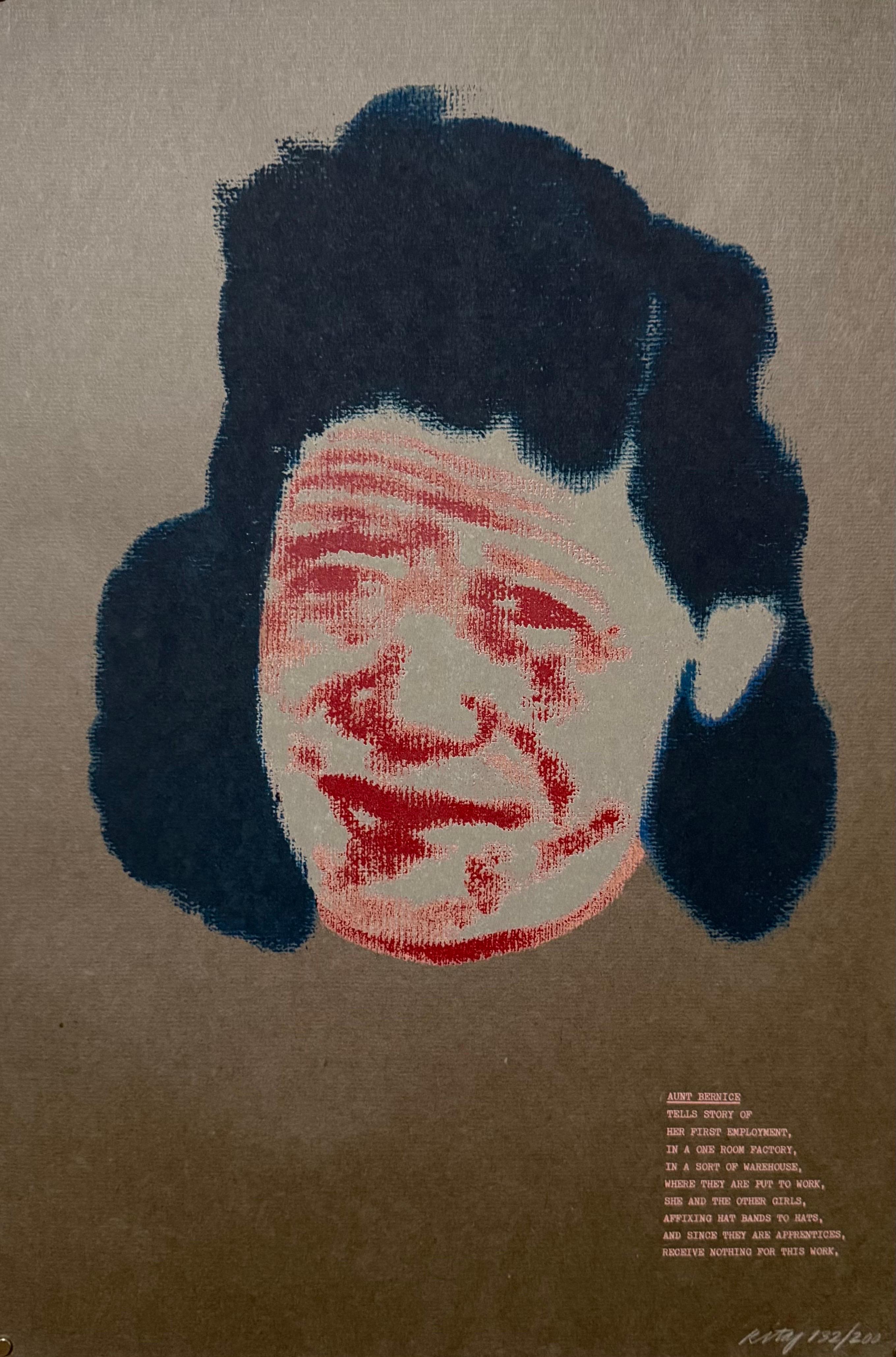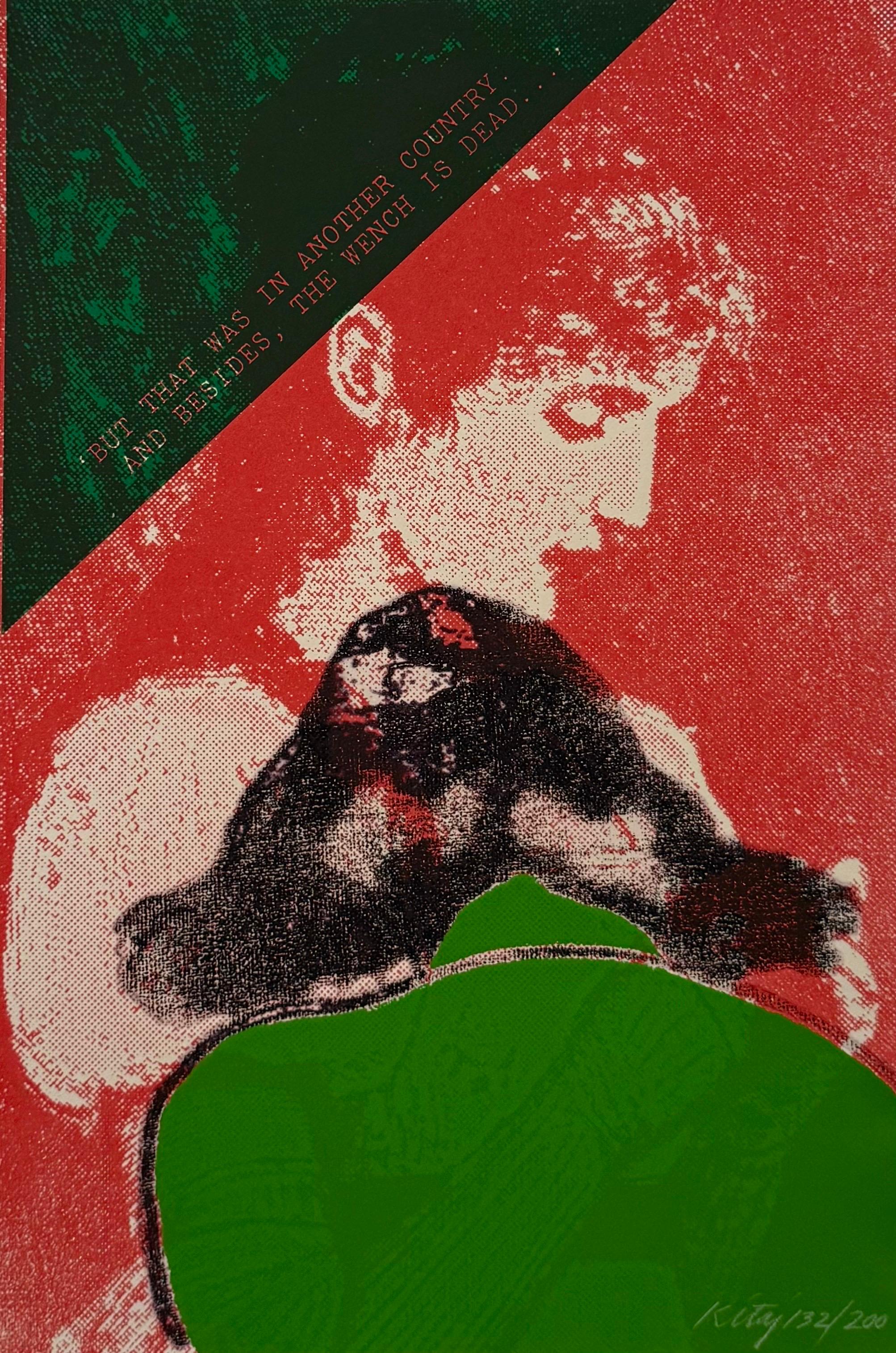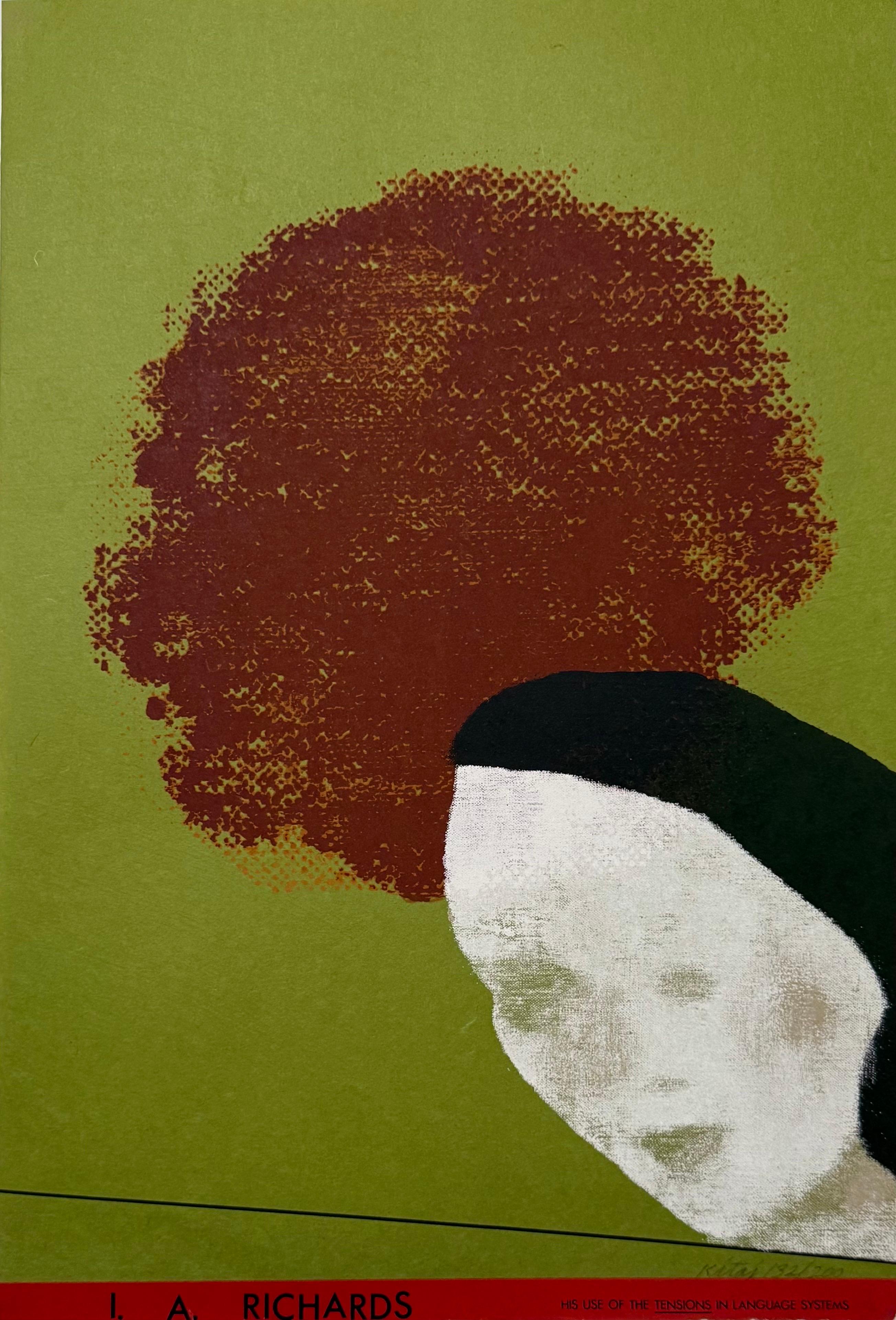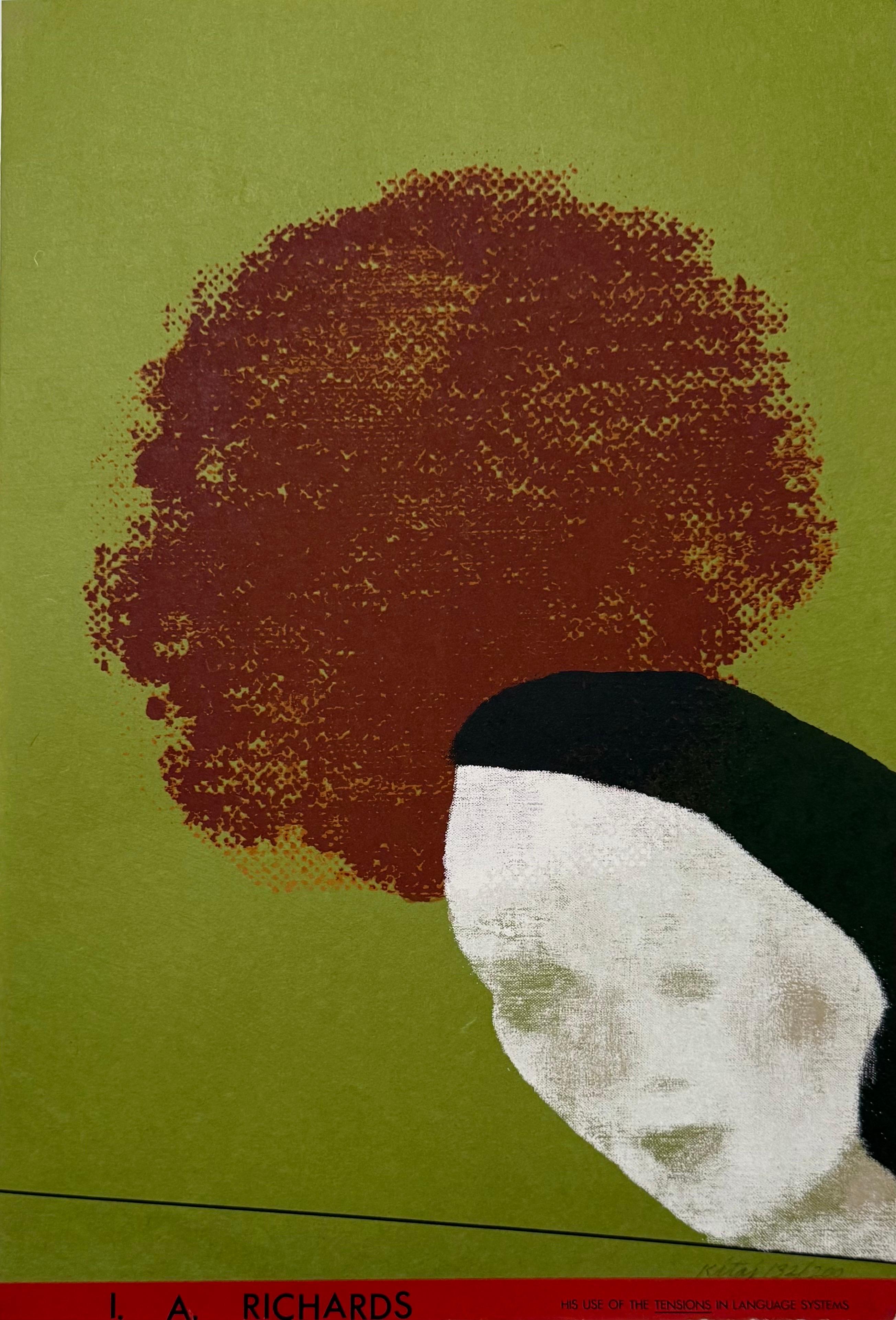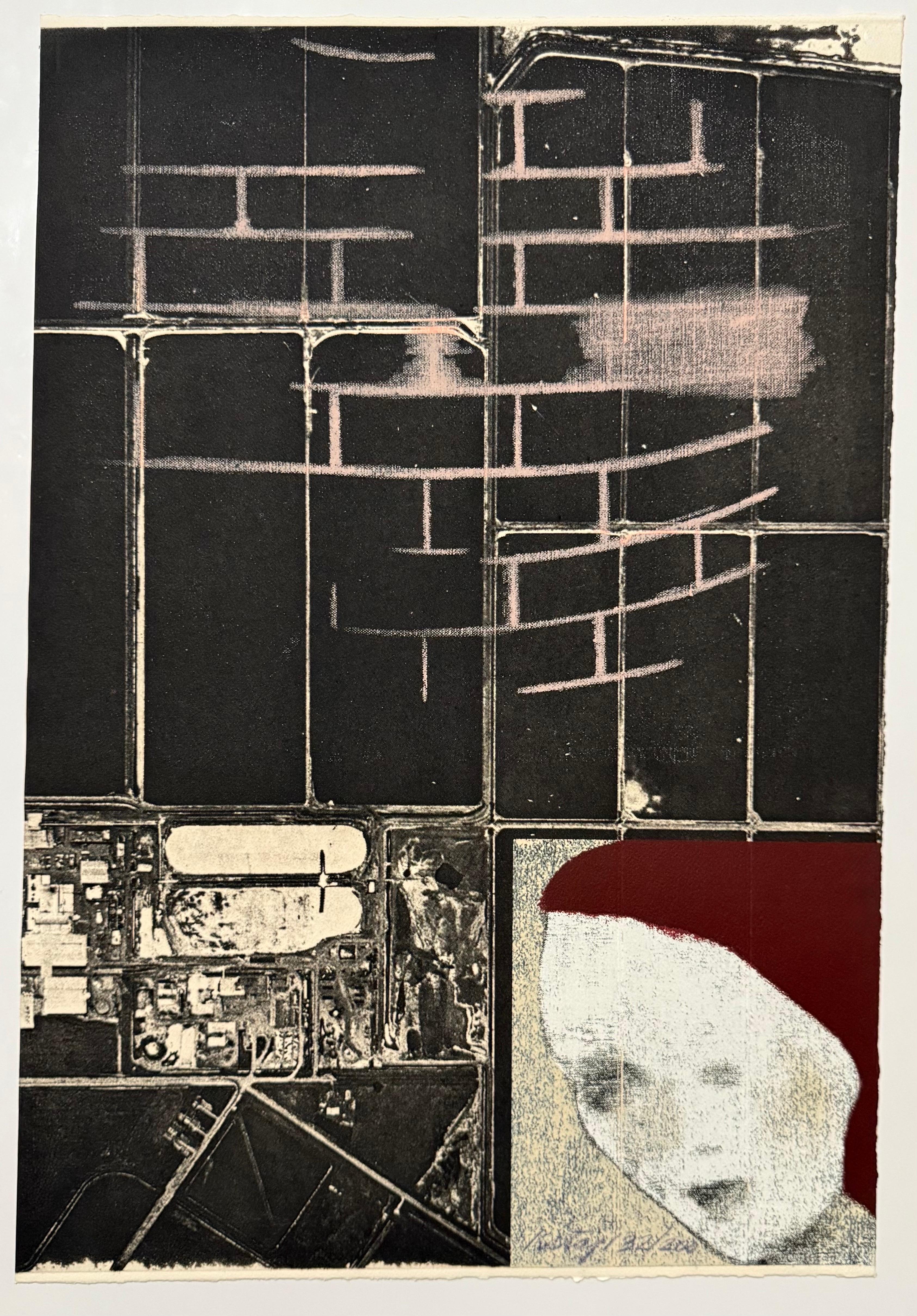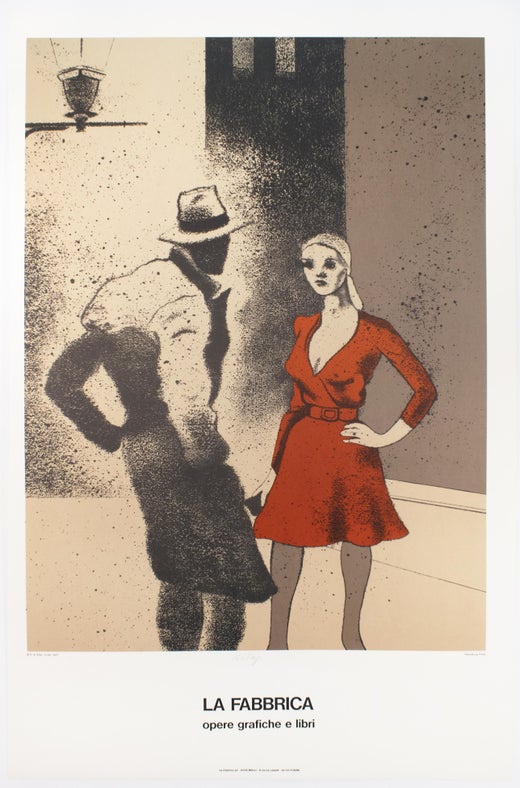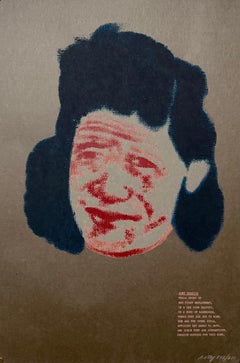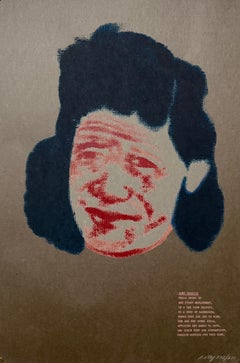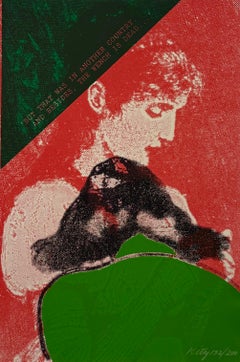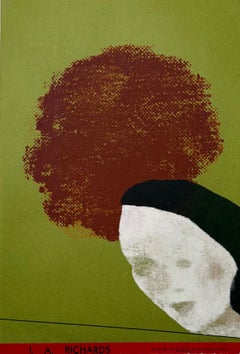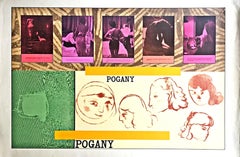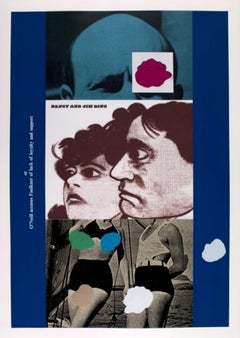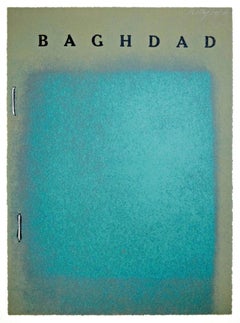Items Similar to British Pop Art Artist RB Kitaj Screenprint Day Book Serigraph Silkscreen Signed
Want more images or videos?
Request additional images or videos from the seller
1 of 8
Ronald Brooks KitajBritish Pop Art Artist RB Kitaj Screenprint Day Book Serigraph Silkscreen Signed1972
1972
$1,200
£917.50
€1,050.24
CA$1,692.14
A$1,842.09
CHF 983.35
MX$22,238.24
NOK 12,364.44
SEK 11,491.94
DKK 7,843.74
About the Item
R.B. Kitaj (British American 1932-2007)
Hand signed and numbered
Screenprint
Measures approximately 24.5 X 16.65 inches
This is from the Robert Creeley daybook. They were done in a variety of mixed media including serigraph, lithograph (Printed by Mourlot in Paris France), photo etching, on acetate, Japanese thin paper, thick almost sandpaper and canvas. They were printed by White Ink LTD London and by Kelpra Studio.
R.B. Kitaj’s A Day Book: Art, Poetry and Collaboration. Produced in conjunction with the writer Robert Creeley, ex-Black Mountain College poet and leading figure of American avant-garde literature
Ronald Brooks Kitaj RA 1932 – 2007 was an American artist with Jewish roots who spent much of his life in England. He became a merchant seaman with a Norwegian freighter when he was 17. He studied at the Akademie der bildenden Künste in Vienna and the Cooper Union in New York City. After serving in the United States Army for two years, in France and Germany, he moved to England to study at the Ruskin School of Drawing and Fine Art in Oxford (1958–59) under the G.I. Bill, where he developed a love of Cézanne, and then at the Royal College of Art in London (1959–61), alongside David Hockney, Derek Boshier, Peter Phillips, Allen Jones and Patrick Caulfield. Richard Wollheim, the philosopher and David Hockney remained lifelong friends.
"Through an earlier pre-occupation with turn-of-the-century intellectual life in Vienna (where he had started his art studies in the early 1950s), as well as an admiration for the Warburg Institute approach to the history of art-in-its-intellectual-context (since after Vienna he had moved to Oxford to study with the art historian Edgar Wind, before going on to the Royal College of Art) Kitaj has come to identify most strongly with the central European Jewish writer Franz Kafka, and with his sense of estrangement and of hidden mysteries. Illustrations to Kafka's aphorisms, imaginary portraits of his fiancée Felice and Count West-West who owned The Castle, appear in the Little Pictures, as do rapidly sketched portraits of Karl Kraus, Paul Celan, Leon Trotsky and Ludwig Wittgenstein, representations of Judeo-Christian mysteries of the hidden face of God.
Kitaj settled in England, and through the 1960s taught at the Ealing Art College, the Camberwell School of Art and the Slade School of Art. He also taught at the University of California, Berkeley in 1968. He staged his first solo exhibition at Marlborough New London Gallery in London in 1963, entitled "Pictures with commentary, Pictures without commentary", in which text included in the pictures and the accompanying catalogue referred to a range of literature and history, citing Aby Warburg's analysis of symbolic forms as a major influence.
He curated an exhibition for the Arts Council at the Hayward Gallery in 1976, entitled "The Human Clay" (an allusion to a line by W. H. Auden), including works by 48 London artists, such as William Roberts, Richard Carline, Colin Self and Maggi Hambling, championing the cause of figurative art at a time when abstract was dominant. In an essay in the controversial catalogue, he invented the phrase the School of London to describe painters such as Frank Auerbach, Leon Kossoff, Francis Bacon, Lucian Freud, Euan Uglow, Michael Andrews, Reginald Gray, Peter de Francia and himself.
Kitaj had a significant influence on British pop art, with his figurative paintings featuring areas of bright colour, economic use of line and overlapping planes which made them resemble collages, but eschewing most abstraction and modernism.[citation needed] Allusions to political history, art, literature and Jewish identity often recur in his work, mixed together on one canvas to produce a collage effect. He also produced a number of screen-prints with printer Chris Prater. He told Tony Reichardt, manager of the Marlborough New London Gallery, that he made screen-prints as sketches for his future paintings. From then onwards Tony Reichardt commissioned Chris Prater to print three or four copies of every print he made on canvas. His later works became more personal.
Kitaj was recognised as being one of the world's leading draftsmen, almost on a par with, or compared to, Degas. Indeed, he was taught drawing at Oxford by Percy Horton, whom Kitaj claimed was a pupil of Walter Sickert, who was a pupil of Degas; and the teacher of Degas studied under Ingres. He staged a major exhibition at Los Angeles County Museum of Art in 1965, and a retrospective at the Hirshhorn Museum in Washington, D.C. in 1981. He selected paintings for an exhibition, "The Artist's Eye", at the National Gallery, London in 1980. In 1981 he was elected into the National Academy of Design as an Associate member and became a full Academician in 1984.
In his later years, he developed a greater awareness of his Jewish heritage, which found expression in his works, with reference to the Holocaust and influences from Jewish writers such as Kafka and Walter Benjamin, and he came to consider himself to be a "wandering Jew". In 1989, Kitaj published "First Diasporist Manifesto", a short book in which he analysed his own alienation, and how this contributed to his art. His book contained the remark: "The Diasporist lives and paints in two or more societies at once." And he added: "You don't have to be a Jew to be a Diasporist."
A second retrospective was staged at the Tate Gallery in 1994. the exhibition moved to the Metropolitan Museum of Art in New York and afterwards to the Los Angeles County Museum of Art in 1995. Kitaj was elected to the Royal Academy in 1991, the first American to join the Academy since John Singer Sargent. He received the Golden Lion at the Venice Biennale in 1995. He staged another exhibition at the National Gallery in 2001, entitled "Kitaj in the Aura of Cézanne and Other Masters".
In September 2010, Kitaj and five British artists including Howard Hodgkin, John Walker, Ian Stephenson, Patrick Caulfield and John Hoyland were included in an exhibition entitled The Independent Eye: Contemporary British Art From the Collection of Samuel and Gabrielle Lurie, at the Yale Center for British Art.
In October 2012 a major international symposium was held in Berlin to mark what would have been Kitaj's 80th birthday. It accompanied Obsessions, the first comprehensive exhibition of Kitaj's work since his death, held at the Jewish Museum, Berlin. The exhibition was shown in the UK in two parts at Pallant House Gallery, Chichester and the Jewish Museum London.
- Creator:Ronald Brooks Kitaj (1932-2007, American)
- Creation Year:1972
- Dimensions:Height: 24.5 in (62.23 cm)Width: 16.65 in (42.3 cm)
- Medium:
- Movement & Style:
- Period:
- Condition:
- Gallery Location:Surfside, FL
- Reference Number:1stDibs: LU38216653472
Ronald Brooks Kitaj
Born in Cleveland, Ohio in 1932, R.B. (Ronald Brooks) Kitaj is considered a key figure in European and American contemporary painting. While his work has been considered controversial, he is regarded as a master draftsman with a commitment to figurative art. His highly personal paintings and drawings reflect his deep interest in history; cultural, social and political ideologies; and issues of identity. Among his various honors are election to the American Academy of Arts and Letters in 1982, and election to the Royal Academy in 1985 (the first American since John Singer Sargent to receive this honor.) Numerous retrospective exhibitions of his work include shows at the Hirshhorn Museum in Washington, D.C.; The Jewish Museum, Berlin; The Jewish Museum, London; and the Hamburger Kunsthalle in Germany. Raised in Cleveland, Ohio, and Troy, New York, Kitaj joined the Merchant Marines in 1949.
In 1950, between sailings, he attended classes at the Cooper Union for the Advancement of Science and Art in New York. He went on to study drawing at the Academy of Fine Art in Vienna, Austria. Kitaj moved to Oxford, England in 1957, and enrolled at The Ruskin School of Drawing and Fine Art, University of Oxford. In 1959, Kitaj was accepted into Royal College of Art, London, where he befriended classmate David Hockney. Upon graduation from the RCA, Kitaj signed with Marlborough Fine Art, London, where he had his first solo exhibition in 1963. His art career began in earnest, and he found critical acclaim alongside commercial success. A second solo show followed at Marlborough Gallery, New York, in 1965, and he sold “The Ohio Gang” to The Museum of Modern Art. In 1969, Kitaj taught for a year at the University of California, Los Angeles. In 1976, he coined the term “School of London” in an essay he wrote as curator of the polemical exhibition, “The Human Clay,” at the Hayward Gallery, London. The term, though loose, continues to define a group of stylistically diverse artists, including Kitaj, who were working in London at that time focusing on figural representation. In 1981, he spent a year in Paris, France, where he focused on drawing and use of pastel. In 1994, the Tate Gallery, London, organized a major retrospective of Kitaj’s work. Hostile and personal attacks from some critics led to what Kitaj referred to as the “Tate War.” The exhibition subsequently traveled to the Los Angeles County Museum of Art and the Metropolitan Museum of Art, New York. Kitaj moved to Los Angeles, California, and continued to exhibit with Marlborough Fine Art and the Marlborough Gallery, New York. In 2001 the National Gallery London organized a solo exhibition of paintings: “R.B. Kitaj In the Aura of Cezanne and Other Masters.” Kitaj focused on his “late style” in his Yellow Studio in Westwood and died in 2007. His gift of his archive to the UCLA Library Special Collections was celebrated with exhibitions at the Skirball Cultural Center and UCLA’s Young Research Library.
About the Seller
4.9
Platinum Seller
Premium sellers with a 4.7+ rating and 24-hour response times
Established in 1995
1stDibs seller since 2014
1,843 sales on 1stDibs
Typical response time: 1 hour
- ShippingRetrieving quote...Shipping from: Surfside, FL
- Return Policy
More From This Seller
View AllBritish Pop Art Artist RB Kitaj Screenprint Day Book Serigraph Silkscreen Signed
By Ronald Brooks Kitaj
Located in Surfside, FL
R.B. Kitaj (British American 1932-2007)
Hand signed and numbered
Screenprint
Measures approximately 24.5 X 16.65 inches
This is from the Robert Creeley daybook. They were done in ...
Category
1970s Pop Art Figurative Prints
Materials
Screen
British Pop Art Artist RB Kitaj Screenprint Day Book Serigraph Silkscreen Signed
By Ronald Brooks Kitaj
Located in Surfside, FL
R.B. Kitaj (British American 1932-2007)
Hand signed and numbered
Screenprint
Measures approximately 24.5 X 16.65 inches
This is from the Robert Creeley daybook. They were done in ...
Category
1970s Pop Art Figurative Prints
Materials
Screen
British Pop Art Artist RB Kitaj Screenprint Day Book Serigraph Silkscreen Signed
By Ronald Brooks Kitaj
Located in Surfside, FL
R.B. Kitaj (British American 1932-2007)
Hand signed and numbered
Screenprint
Measures approximately 24.5 X 16.65 inches
This is from the Robert Creeley daybook. They were done in ...
Category
1970s Pop Art Figurative Prints
Materials
Screen
British Pop Art Artist RB Kitaj Screenprint Day Book Serigraph Silkscreen Signed
By Ronald Brooks Kitaj
Located in Surfside, FL
R.B. Kitaj (British American 1932-2007)
Hand signed and numbered
Screenprint
Measures approximately 24.5 X 16.65 inches
This is from the Robert Creeley daybook. They were done in ...
Category
1970s Pop Art Figurative Prints
Materials
Screen
British Pop Art Artist RB Kitaj Screenprint Day Book Serigraph Hand Signed
By Ronald Brooks Kitaj
Located in Surfside, FL
R.B. Kitaj (British American 1932-2007)
Hand signed and numbered
Screenprint
Measures approximately 24.5 X 16.65 inches
This is from the Robert Creeley daybook. They were done in a...
Category
1970s Pop Art Figurative Prints
Materials
Screen
British Pop Art Artist RB Kitaj Screenprint Day Book Serigraph Silkscreen Signed
By Ronald Brooks Kitaj
Located in Surfside, FL
R.B. Kitaj (British American 1932-2007)
Hand signed and numbered
Screenprint
Measures approximately 24.5 X 16.65 inches
This is from the Robert Creeley daybook. They were done in ...
Category
1970s Pop Art Figurative Prints
Materials
Screen
You May Also Like
R.B. Kitaj, Civic Virtue All Over The Floor, 53/100, Screenprint, 1967
By Ronald Brooks Kitaj
Located in San Francisco, CA
ABOUT
R.B. Kitaj, Civic Virtue All Over The Floor
Screenprint, Serigraphy.
Edition of 100. 53/100.
Signed in pencil lower left.
Unframed.
CREATOR R.B. Kitaj, United Kingdom. ...
Category
Mid-20th Century British Folk Art Contemporary Art
Materials
Paper
$1,440 Sale Price
20% Off
POGANY rare 17 color 1960s British Pop silkscreen signed numbered edition of 70
By Ronald Brooks Kitaj
Located in New York, NY
R.B. Kitaj
POGANY, 1966
17 colour Screenprint and Photo-screenprint
24 × 36 inches
Pencil signed and numbered from the Limited Edition of 70
Hand-signed by artist, Signed & numbered ...
Category
1960s Pop Art Abstract Prints
Materials
Screen, Pencil
O'Neill accuses Faulkner of lack of loyalty and support (Nancy & Jim Dine)
By R.B. Kitaj
Located in New York, NY
Ronald B. (R.B.) Kitaj
Nancy and Jim Dine, or O'Neill accuses Faulkner of lack of loyalty and support (Kinsman 40), 1970
16 Color Silkscreen with collage and coating on different wove papers
Hand signed and numbered in pencil 29/70 on the front. The back (which is framed) bears the Kelpra Studio blindstamp
Frame included: held in the original vintage metal frame
Very rare stateside. Other editions of this work are in the permanent collections of major institutions like the British museum, which has the following explanation: "The artist Jim Dine and his wife Nancy were close to Kitaj and his family, especially after the death of Elsi, Kitaj's first wife in 1969. They sometimes stayed with the Dines at their farm in Vermont during Kitaj's second teaching sojourn in the United States. Dine and Kitaj held a joint show at the Cincinnati Museum of Art in 1973. In the catalogue both artists contributed an insightful 'essay' on each other with Dine stressing Kitaj's obsession with all things American and baseball-related...' The alternate title, "O'Neill accuses Faulkner of lack of loyalty and support" can be seen on the artwork itself, and clearly is some kind of inside joke among friends. By the way -- do you see the way the colored dots are placed over the figures? Kitaj was doing this well before Baldessari who made it famous; that's how pioneering he was at the time.
Referenced in the catalogue raisonne of Kitaj's prints, Kinsman, 40
Published and printed by Chris Prater of Kelpra Studio, Kentish Town, United Kingdom
Ronald Brooks (RB) Kitaj Biography
R.B. (Ronald Brooks) Kitaj was born in 1932 in Cleveland Ohio. One of the most prominent painters of his time, particularly in England where he spent some four decades spanning the late 1950s through the late 1990s, Kitaj is considered a key figure in European and American contemporary painting. While his work has been considered controversial, he is regarded as a master draughtsman with a commitment to figurative art. His highly personal paintings and drawings reflect his deep interest in history; cultural, social and political ideologies; and issues of identity.
Part of an extraordinary cohort who emerged from the Royal College of Art circa 1960, which included Peter Blake, Patrick Caulfield, and David Hockney, Kitaj was immediately pegged as one of its leading figures. The London Times greeted his first solo show in 1963 as a long-awaited and galvanizing event: “Mr. R.B. Kitaj’s first exhibition, now that it has at last taken place, puts the whole ‘new wave’ of figurative painting in this country during the last two or three years into perspective.” In 1976, KItaj curated the exhibition The Human Clay, and in the essay he wrote for it he proposed the existence of a “School of London”—a label which stuck to a group of painters that includes Francis Bacon, Frank Auerbach, Lucian Freud, Leon Kossoff, Michael Andrews...
Category
1970s Pop Art Portrait Prints
Materials
Mixed Media, Screen, Pencil
BAGHDAD Six color screenprint, renowned British Pop pioneer R.B. Kitaj, Signed/N
By Ronald Brooks Kitaj
Located in New York, NY
Ronald Brooks (R.B.) Kitaj
BAGHDAD, 1972
Six Color Screenprint and Photoscreenprint
20 × 14 1/2 inches
Pencil signed and numbered 1/125
Printed at Kelpra Studio, London
Published by ...
Category
1970s Pop Art Abstract Prints
Materials
Screen
"Performing Arts Center" lithograph by R. B. Kitaj from "New York, New York"
By Ronald Brooks Kitaj
Located in Boca Raton, FL
"Performing Arts Center" lithograph of dancers and musicians by R. B. (Ronald Brooks) Kitaj from the "New York, New York" portfolio published by the New York Graphic Society. Signed ...
Category
1980s Contemporary Figurative Prints
Materials
Lithograph
Girl III - 1968 Signed Limited Edition Lithograph
By Alistair Grant
Located in Rochester Hills, MI
Alistair Grant
Girl III - 1968
Print - Lithograph 23½″ x 31'' inches
Edition: Signed in white pencil, titled and marked Artist Proof
Alistair Grant was a great and justly-rever...
Category
1960s Pop Art Figurative Prints
Materials
Lithograph
$2,400 Sale Price
20% Off
More Ways To Browse
Golden Lion
Hirschfeld Marx Brothers
Hirschfeld Phantom
Hisashi Otsuka
Invader Kit
Ivan Valtchev
Jack Eisner
Jacob Lawrence Signed
James Jacques Joseph Tissot On Sale
James L Thomas
Japanese Linocut
Japanese Woodcuts 18th Century
Jayme Odgers
Jean Cocteau Lovers
Jean Yves Commere
Jehudo Epstein
Jim Dine Hammers
Jim Dine Rimbaud
